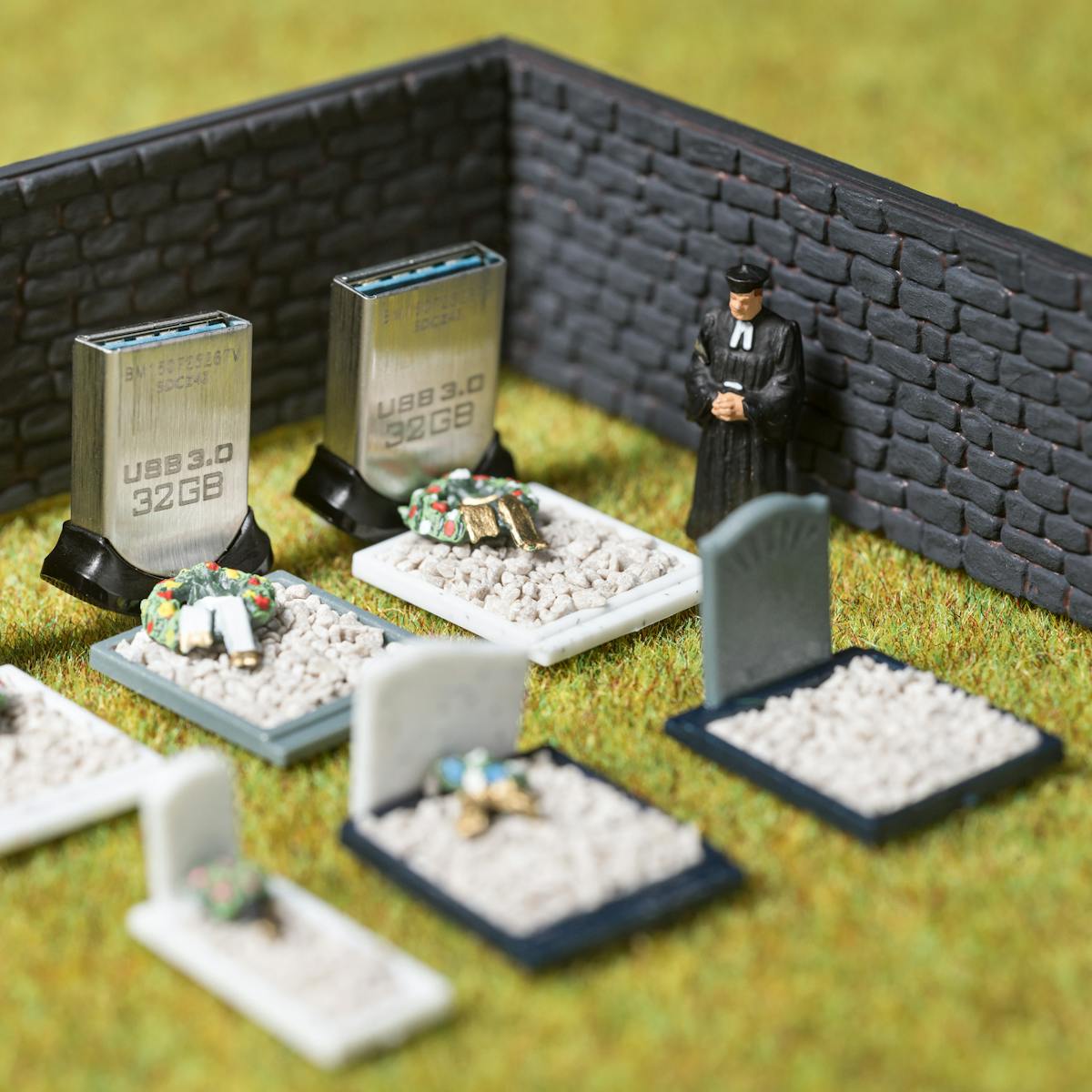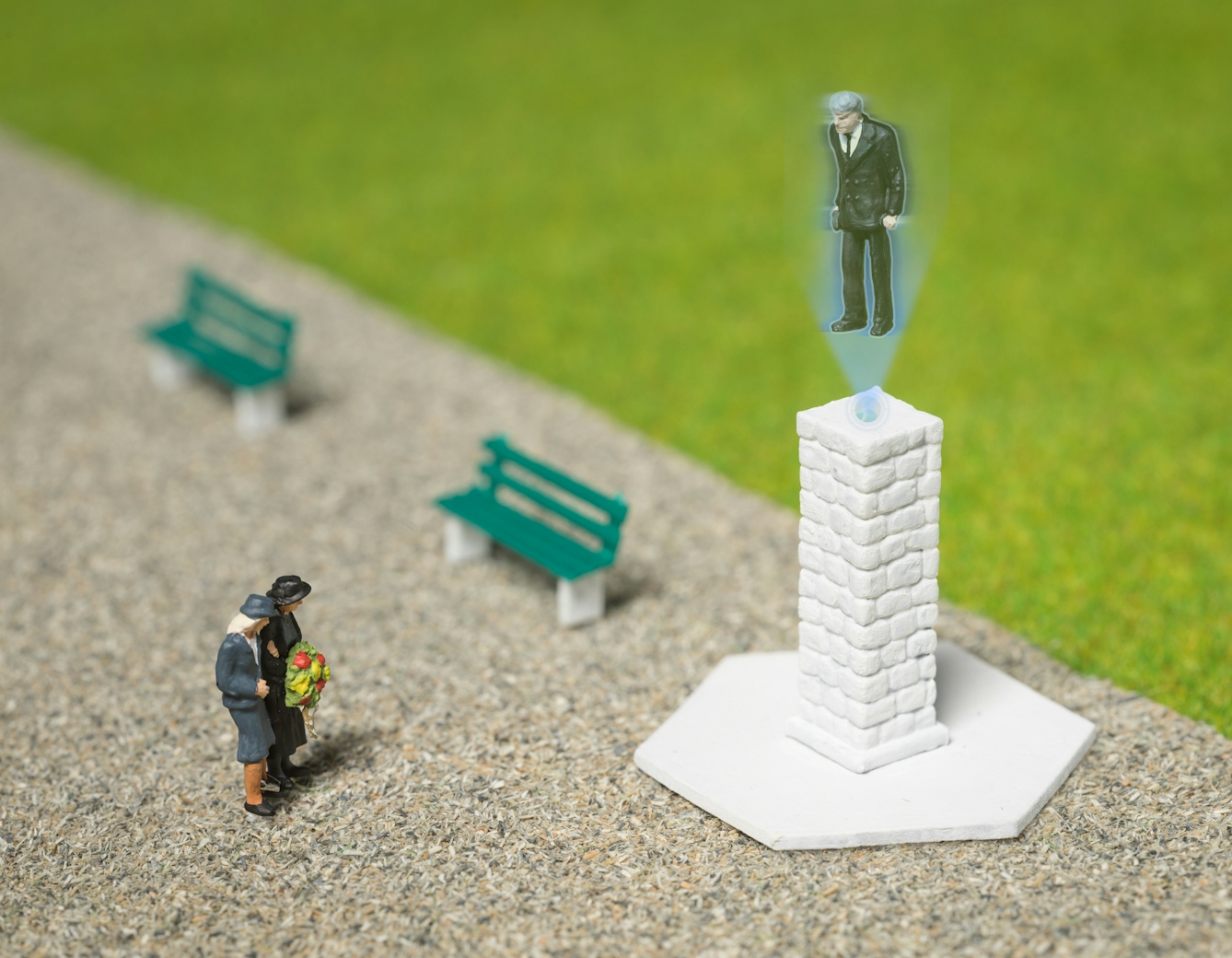When we die, our data lives on. Our blogs, vlogs, social media accounts and emails we sent can be a permanent digital legacy. You might be tempted to stick your head in the sand just reading that, but it’s possible – and probably advisable – to plan a dignified digital demise.

In one of the artists’ studios below London’s neoclassical arts hub Somerset House, I am handed a curious object: a USB stick completely encased in clear epoxy. Printed on it is the French phrase “ne me quitte(s) pas” (from the classic love song by Belgian singer/songwriter Jacques Brel). This is a demonstration model of what participants receive in the performance of ‘Goodnight Sweetheart’ by Audrey Samson.
At a series of installations across the globe, the Canadian artist has been offering “digital data funerals”, where she dons a gas mask and protective gloves to symbolically dispose of all or a portion of someone’s online life, loaded onto one of these memory sticks, which she immerses in a block of fast-hardening resin.
As Samson makes clear with the somewhat ironic ritualistic aspect of ‘Goodnight Sweetheart’, erasing such data is actually very difficult. And this raises some equally difficult questions. It is not an issue that has troubled me duly until now: yes, I have noted down a few important log-in details for my missus, but beyond that have not thought at all about what will happen to my emails, digital images and postings spread across various social media accounts. Would I want them saved as a memorial or wiped away to save someone else the hassle?
How we face mortality and its commemoration is changing as our lives become increasingly digital: should we plan for what happens to our digital assets? And are social media platforms worthy places for memorials?
Living on through social media
Artists and academics have been musing on such questions since the early days of the internet, although new media companies have been slower to adapt their services to the fact that users die off and that people may actually care. Instead, these companies seem more concerned with their bottom line: in November 2019, Twitter threatened to purge inactive accounts, ostensibly to free up names for new users, but is now rethinking the plan after a backlash from those seeking to maintain posts from the deceased.
Other providers approach the challenge in different ways: Google offers the Inactive Account Manager service, while Facebook introduced the legacy contact option – allowing a trusted party to take control of someone’s page – in 2015. Before that the choice was either freezing an account as a memorial or deleting it.
Since Samson devised ‘Goodnight Sweetheart’ in 2014, she has seen how the public’s awareness of issues surrounding data politics has grown. “In the very beginning it was 99 per cent ‘I have never considered this before’,” she says. “Probably this year most people have heard about it, but maybe not thought about it profoundly. They’ve not dealt with it in the way many people haven’t sorted out their wills.”
Treasured memories or mementos could be wiped clean without our assent, or thoughts and images that we would prefer to have edited could be indelibly fixed.

Digital ghosts 02.
It is often news stories that have captured people’s attention, sometimes via tragic events, such as the death in 2014 of Hollie Gazzard. The Gloucester hairdresser’s Facebook page was memorialised after she was murdered by her ex-boyfriend, unfortunately leaving pictures of the pair together that the site refused to take down, until Hollie’s parents organised a publicity campaign involving an 11,000-signature petition.
Dr John Troyer, Director of the Centre for Death and Society at the University of Bath, has been getting to grips with such issues for the best part of two decades, though the reality hit home when his sister Julie tragically died of brain cancer in 2018. Although she had not made any plans for her digital assets, Troyer found he could control his sister’s Facebook account from her phone, installing himself as legacy contact to access photos for their parents, contact her friends and raise money to pay for expenses.
Yet even an expert such as Troyer was not prepared for every eventuality, forgetting that when he accessed her account, Julie appeared to her contacts to be online. Luckily, a mutual friend got in touch straight away so he could disable that function. “I was in the situation of knowing exactly what to do, but also finding it extremely bizarre to be in the middle of it. There’s stuff that wasn’t done, but looking back, that’s OK. At the time, grief magnifies it like you wouldn’t believe.”
Troyer keeps a document with his own wishes and a spreadsheet of account details, and since his sister’s death he has reminded his parents to write theirs down as well.
Messages from the grave
Nowadays, holding details of online accounts and instructions for their disposal is a service increasingly offered by legal firms that deal in estate planning. Other companies also offer to store personal data in secure places, though Troyer warns that some of these organisations have already disappeared. “This has always been my challenge to companies that want to offer such a product: how does your service work in 10 or 20 years?” While executors of a will are compelled by law to carry out your instructions as far as possible, private firms are not so legally bound.
Other firms offer the ability to communicate once we have gone, by storing message videos to be sent to selected people at a future date, say from a parent to a child for an important birthday. Dr Stacey Pitsillides, a senior research fellow in design at Northumbria University, has been putting this possibility to the public in her ‘Tickets for the Afterlife’ events and has found them potentially more engaging than earlier examples, such as leaving letters.
“In some ways, we’ve always been able to do that, but the voice is a very powerful aspect, along with the idea that you send it at a particular time to a particular person.” Though again, the longevity of such enterprises remains an issue. “That’s what’s interesting about these companies that use words like ‘future’, ‘eternity’ or ‘for ever’. They claim to be quite solid, but that can be quite questionable.”

Digital ghosts 03.
Planning your digital death
Our data, then, faces disparate threats from unthinking or unreliable service providers: treasured memories or mementos could be wiped clean without our assent, or thoughts and images that we would prefer to have edited could be indelibly fixed. Perhaps it is best that we take a proactive approach, as suggested by several protagonists in Oreet Ashery’s film ‘Revisiting Genesis’.
Here, the artist explores how dying people come to terms with their digital legacies through the interactions of various characters, including nurses and carers. One suggests Samson’s data funeral to a patient as a means of sloughing off their online baggage. Another raises a more positive possibility: sharing such information via an augmented-reality gravestone that gives mourners the option of accessing digital content in traditional places of commemoration, namely graveyards and gardens of remembrance.
Such technology already exists. Nowadays, when you order your gravestone or plaque, you could opt to add a Quick Response (QR) code. These markers are more familiar from accessing special offers in adverts, but here are cut into stone or metal, allowing mobile devices to link to online information, such as videos or biographies.
A real-life example is the memorial in a Southampton graveyard to Henry ‘Harry’ Witt, a stoker who died aboard the Titanic. Tracy Dunne, mother-in-law of a descendant of Harry, suggested the upgrade when a new memorial at the family grave was needed. It links to a website containing Harry’s career records and other memorabilia.
One problem with the use of such technology is the speed of change in IT: will QR codes last as long as graveyards? Tracy, though, finds the system works for her family’s situation. “We may change it in the future, but there are guided walks around the cemetery and we do get plenty of hits. It’s online so you don’t have to go the burial site, so we have family members in Australia that can look up the page, so it will remain online even if QR codes go out.”
Using dead people’s data
Looking further ahead, Ashery also examines futuristic possibilities such as uploading memories to create digital avatars for future generations to interact with. Though this isn’t yet a possibility, people are already being invited to export biographical information and other data that could be used to create such a phenomenon. Dr Pitsillides finds the concept useful for starting a wider debate about identity.
“Engaging the public in these issues brings to light other questions: it is not just what these technologies do and how they change our rituals and practices, but how they make us reflect on ourselves and what it means to be human.”
For Ashery, there are even more pressing concerns: “Everything we do online is extracting data from us, which not only contributes to ideas of algorithms, artificial intelligence and prediction of behaviour, but it’s used for financial gain, to foresee market trends and voting intentions. Before we had magic and séances; now we have technology taking that role. We have to be aware and critical of the extension of capitalism into death. We have to learn how to have control.”
About the contributors
Chris Mugan
Chris Mugan is a freelance journalist with interests ranging from art and music to travel and design. He has written on these areas for publications including the Independent, the i newspaper, the Financial Times and Art Quarterly. Chris has also contributed to books on fine art and design published by Phaidon.
Steven Pocock
Steven is a photographer at Wellcome. His photography takes inspiration from the museum’s rich and varied collections. He enjoys collaborating on creative projects and taking them to imaginative places.

